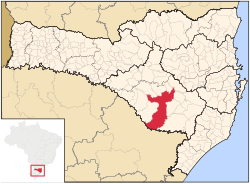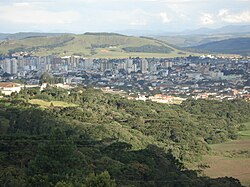History
In the beginning of the 17th century, the arrival of the first Europeans established the town. The growing of Lages was due to the opening of roads to reach the fields of Rio Grande do Sul. The people of São Paulo and Minas Gerais were attracted to this region due to the cattle-breeding business with the gauchos .
Very primitive documents mention Lages as a stop for horse riders that were traveling from Sorocaba or São Paulo, transporting mules, horses and cattle. Correia Pinto, the founder, was a horse rider, and ran cattle groups from Lages to São Paulo.
In 1766, Lages becomes a village. In 1820 it detached itself from São Paulo to be part of the state of Santa Catarina. On May 25, 1860, it was elevated to city status. In 1960, the city's current name was adopted.
During the Revolução Farroupilha, Lages belonged to the Juliana Republic.
Lages is served by Antônio Correia Pinto de Macedo Airport and Planalto Serrano Regional Airport located in the adjoining municipality of Correia Pinto.
Geography
Lages is located in the mountain region of the state and is the largest municipality of it. It is the main city of this region, and borders the towns of Otacílio Costa, São Joaquim, and Correia Pinto. The main course of urban water is Carahá River.
Climate
Lages has a temperate oceanic climate (Koppen: Cfb), with an annual mean temperature of 16 °C (61 °F). Winter temperatures can stay below freezing, with occurrence of frost and snow. During the summer, temperatures may reach 30 °C (86 °F) and droughts may occur.
Records
Data by INMET shows that the lowest temperature recorded in the city between 1961 and 2017 was −6 °C (21 °F) on 14 July 2000 [3] and the highest was 34.5 °C (94.1 °F) on 9 January 2006. [4] On 1 October 2001, the city accumulated a record of 177 millimetres (7.0 in) of precipitation in a period of 24 hours. Previous large accumulations include 122 millimetres (4.8 in) on 22 October 1979 and 117.2 millimetres (4.61 in) on 16 April 1971. [5]
With 671.4 millimetres (26.43 in), August 1983 was the month with the most accumulated precipitation. [6] The lowest relative humidity observed was of 20% on 13 November 1971. [7]
| Climate data for Lages (1991–2020 normals, extremes 1961–2017) |
|---|
| Month | Jan | Feb | Mar | Apr | May | Jun | Jul | Aug | Sep | Oct | Nov | Dec | Year |
|---|
| Record high °C (°F) | 34.5
(94.1) | 34.3
(93.7) | 33.2
(91.8) | 30.8
(87.4) | 27.9
(82.2) | 25.6
(78.1) | 26.9
(80.4) | 31.0
(87.8) | 32.4
(90.3) | 32.6
(90.7) | 34.4
(93.9) | 33.9
(93.0) | 34.5
(94.1) |
|---|
| Mean daily maximum °C (°F) | 26.8
(80.2) | 26.6
(79.9) | 25.3
(77.5) | 22.6
(72.7) | 18.8
(65.8) | 17.3
(63.1) | 17.2
(63.0) | 19.4
(66.9) | 19.7
(67.5) | 21.7
(71.1) | 24.0
(75.2) | 26.1
(79.0) | 22.1
(71.8) |
|---|
| Daily mean °C (°F) | 20.6
(69.1) | 20.6
(69.1) | 19.2
(66.6) | 16.7
(62.1) | 13.0
(55.4) | 11.5
(52.7) | 11.1
(52.0) | 12.8
(55.0) | 13.9
(57.0) | 16.2
(61.2) | 17.9
(64.2) | 19.9
(67.8) | 16.1
(61.0) |
|---|
| Mean daily minimum °C (°F) | 16.3
(61.3) | 16.4
(61.5) | 15.2
(59.4) | 12.7
(54.9) | 9.1
(48.4) | 7.6
(45.7) | 7.0
(44.6) | 8.1
(46.6) | 9.8
(49.6) | 12.2
(54.0) | 13.4
(56.1) | 15.3
(59.5) | 11.9
(53.4) |
|---|
| Record low °C (°F) | 5.4
(41.7) | 7.0
(44.6) | 2.3
(36.1) | −0.7
(30.7) | −3.4
(25.9) | −5.8
(21.6) | −6.0
(21.2) | −4.8
(23.4) | −4.0
(24.8) | 0.2
(32.4) | 2.9
(37.2) | 3.2
(37.8) | −6.0
(21.2) |
|---|
| Average precipitation mm (inches) | 177.6
(6.99) | 167.0
(6.57) | 126.6
(4.98) | 115.1
(4.53) | 120.7
(4.75) | 126.7
(4.99) | 159.3
(6.27) | 125.6
(4.94) | 175.0
(6.89) | 201.4
(7.93) | 138.1
(5.44) | 149.1
(5.87) | 1,782.2
(70.17) |
|---|
| Average precipitation days (≥ 1.0 mm) | 13 | 12 | 10 | 8 | 8 | 8 | 9 | 8 | 10 | 12 | 10 | 11 | 119 |
|---|
| Average relative humidity (%) | 78.8 | 80.1 | 80.6 | 81.8 | 84.1 | 85.5 | 84.0 | 80.1 | 80.6 | 81.1 | 77.1 | 76.6 | 80.9 |
|---|
| Mean monthly sunshine hours | 199.8 | 173.8 | 181.2 | 158.9 | 145.4 | 128.6 | 145.5 | 166.8 | 141.6 | 150.4 | 195.7 | 195.1 | 1,982.8 |
|---|
| Source: Instituto Nacional de Meteorologia [8] [9] [10] [11] [12] [13] [14] [15] Absolute temperature records: 1 January 1961 to 3 April 2017) [3] [4] |
This page is based on this
Wikipedia article Text is available under the
CC BY-SA 4.0 license; additional terms may apply.
Images, videos and audio are available under their respective licenses.











